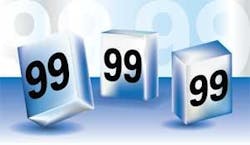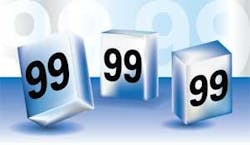Hard to Code
Some services provided by dental offices are tough to categorize for claim forms.
The ADA Code Revision Committee (CRC) updates dental codes every two years. The code set that is mandated by HIPAA (Health Insurance Portability and Accountability Act) is the ADA Current Dental Terminology 2007-2008. This CDT-2007-2008 is the official terminology for reporting dental services, and everyone in dentistry must use it to code dental procedures. (This does not mean that, when appropriate, a dentist may not report a service to a medical plan using medical codes.) Both the dental profession and the insurance industry have members serving on the Code Revision Committee. Dentists and hygienists may be surprised to know that the Code is a collaboration between insurance carriers and dentistry, rather than a "solo production" of the ADA.
While there are already hundreds of codes describing dental services, the CDT is typically somewhat behind the development of treatments and materials in use in dental offices. In addition, some services that have been performed for many years, such as a so-called "difficult prophy," still do not have specific codes. Changes in the Code must occur according to guidelines and criteria for change, not just because certain persons may desire a new code. (To view CRC criteria for new codes, see the ADA.org website. Dentists, hygienists, and others can suggest new codes online. Input for the CDT 2009-2010 is already closed; however, suggestions can still be made for the 2011-2012 revision.)
Services that do not have a designated code may be described by a "99" code (D0999-D9999). These so-called "unspecified" codes are depicted in the CDT as being appropriate for use for any procedure that is not adequately described by a designated code. For example, any periodontal procedure that does not have a specified code may be reported using D4999-Unspecified Periodontal Procedure, by Report. Whenever a "99" code is placed on a claim form, a narrative describing the service and what it was for must accompany it. This is usually best accomplished by placing the explanation directly on the claim form in section #35-Remarks rather than sending or emailing an attachment.
Codes for Products?
There are no codes for dental "products" or certain techniques. There are, however, codes for procedures/services where certain products or techniques might be used, such as D0431-Adjunctive Pre-Diagnostic Test. Various cancer screening products might be used, but the code is for the service, not the product. Similarly, when someone asks, "What is the code for laser surgery?" the answer is: there isn't one. The use of a laser can provide a technique for facilitating a service such as surgery, but does not enjoy a code of its own.
Of Interest to Hygienists
• Interestingly, many brands of varnish have packaging that states their products are for sensitivity only. Despite this, the CDT definition specifically states that the code for a varnish, D1206-Topical Fluoride Varnish-Therapeutic Application for Moderate to High Caries Risk Patients, is "not to be used for desensitization," but is used for caries prevention only. Many offices are using the varnish for both. Practically speaking, most insurance carriers will provide a benefit for this service for individuals under the age of 14, one time per year as a means of preventing decay. Individuals over the age of 14 may also be provided a benefit if they have a history of caries, or have caries at the time of the service. Benefits for desensitization are not typical.
• Application of MI (minimum intervention) Paste is believed to provide accessible calcium and phosphate to help re-mineralize tooth surfaces. It is described by the manufacturer as being appropriate for sensitivity, use with or after braces, post-whitening and other situations. D9910-Application of Desensitizing Medicament might be used for this service, although few carriers will provide a benefit. Also, be aware that MI paste contains proteins that are derived from milk. (Does your office medical history include a question regarding milk allergies? See one at steppingstonestosuccess.com.)
• More products are also becoming available for oral cancer screening. These include ViziLite, OraScan (toluidine blue), and others. D0431-Adjunctive Pre-Diagnostic Test That Aids in Detection of Mucosal Abnormalities, including Pre-malignant and Malignant Lesions, not to Include Cytology or Biopsy Procedures may apply to these.
Some carriers are already covering oral cancer screening tests, with more likely in the future. If abnormalities are discovered in a screening, the next step may be a D7288-Brush Biopsy-Transepithelial Sample Collection (which may apply to the Oral CDx service, but was not developed for that product), or D7286-Biopsy of Oral Tissue-Soft . These two codes are frequently covered by dental plans, with the provision that a copy of the lab report is included as an attachment. Codes for lab reports include D0472-D0502.
• Pocket irrigation is a service provided by many hygienists in conjunction with various periodontal procedures. However, there is no specific code for such irrigation. Interestingly, although the CDT-2007-2008 does not place the word "irrigation" in its description of D4910-Periodontal Maintenance, the American Academy of Periodontology "Parameters of Care" May 2000 does include the words, "antimicrobial agents as necessary" in their definition of "Parameter on Periodontal Maintenance."
Most carriers consider irrigation to be included in a "larger" service. So ... is there any way to "code" irrigation?
Non-contract provider offices might want to simply use the code for the "larger" service and raise the fee to cover the cost of irrigation. Contract provider offices may not be able to do this. Some Delta plans advise offices to use D9999-Unspecified Adjunctive Procedure, by Report, although this code will not typically be paid by their plans. Other insurers advise the use of D4999-Unspecified Periodontal Procedure, by Report. The use of any "99" code will likely delay a claim, and may result in the code not being paid anyway. However, if the dentist or office is a contract provider for a plan, the denial for payment may open the door for the office to be able to bill the patient for the charge. Otherwise, the dentist may noy be able to bill the patient for a higher fee for D4910 when irrigation is used, because he/she has agreed to accept a Maximum Allowable Benefit or other designated fee for his/her services. A higher fee may be "disallowed" by the contract between the dentist and the carrier and therefore, the dentist may not charge more.
Why do dentists agree to be contract providers under these types of contract conditions? The answer is because many of the plans cover large portions of the patient population. It is estimated that Delta plans cover one out of every four individuals who have dental insurance. While dealing with the insurance and denials may be a problem, not working with certain types of insurance can be very detrimental to an office financially.
• Periodontal probing is another service that does not enjoy its own code. Probing is considered by the ADA to be a part of any examination or evaluation. Therefore, any office which provides a multiple-visit "tissue maintenance" plan needs to be sure that patients understand why they are coming for their appointments and what the ultimate charges are going to be. In most cases, the majority of the cost will be borne by the patient directly.
Exam or evaluation codes have been revised frequently, but the upshot is that most insurers will pay for two D0120-Periodic Oral Evaluation services annually, and one D0150-Comprehensive Oral Evaluation or D0180-Comprehensive Periodontal Evaluation every three to five years. D4910-Periodontal Maintenance does not include the evaluation or exam portion of the patient's visit; therefore, it is still correct to bill out an exam code when the dentist performs an evaluation at the time of the D4910. The office may choose whatever evaluation code it desires; however, the parameters listed above will typically apply.
Hygienists usually see patients more frequently than the dentists in the practice. So it often falls to the hygienist to help patients understand something about their insurance plans, or at least talk to patients about the limited nature of dental plans. While working with insurance may be frustrating, a patient's dental plan may be the primary reason the patient has come into the practice. Patients make paydays possible.
About the Author
Carol Tekavec CDA RDH is a practicing dental hygienist, author of the Dental Insurance Coding Handbook 2005-2008 and a patient brochure, "My Insurance Covers This…Right?" She is the designer of a dental chart endorsed by the Colorado Dental Association and others, and the president of Stepping Stones to Success. She has appeared at all major dental meetings, and is a presenter for the ADA Seminar Series. Contact her by phone at 800-548-2164 or visit her web site at steppingstonestosuccess.com.

